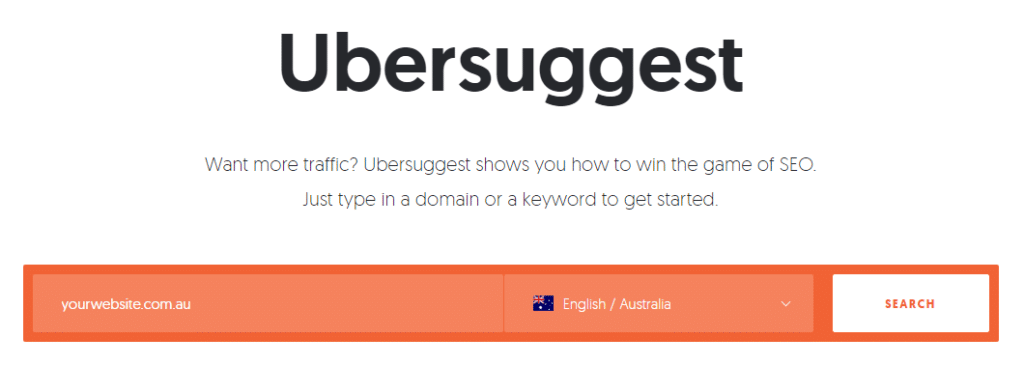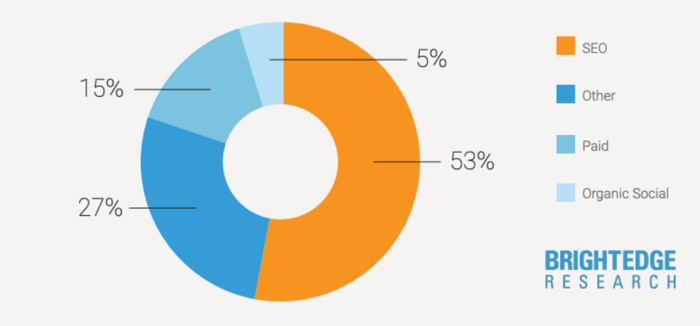At the end of the day all that matters is the value you receive from an investment such as Search Engine Optimisation (SEO). There are two primary metrics when considering the value and efficacy of a website: Impressions and Conversions. Impressions basically describe the number of times your website is visible to a user, i.e. in a search result. A conversion describes any time a user takes a desirable action based on your business goals. A simple example of a macro conversion, or sale, is when a client signs off on a new build. A micro conversion might be when someone calls or emails you through the website. I.e. each forms a step toward the actual sale. Our aim is to improve your website on all fronts. Our combined experience in design, development and marketing allows us to provide this as an all-in-one service.
It’s important that your website performs on all fronts – consider branding, design, development and marketing.
The table below indicates the distribution of general click data on Google Search Engine Result Pages (SERP). This data has been averaged from several sources. Regardless, one thing is clear – a better position on google leads to an increasingly higher number of clicks.
| Position in Search Engine Result Page (SERP) | Average Click Through Rate (CTR) |
| 1 (the top and most sought after position) | 31.73% |
| 2 | 24.71% |
| 3 | 18.66% |
| 4 | 13.60% |
| 5 | 9.51% |
| 6 | 6.23% |
| 7 | 4.15% |
| 8 | 3.12% |
| 9 | 2.97% |
| 10 | 3.09% |
Whilst these numbers are always fluctuating, the gist is the same. Position 1 receives approximately 10x more clicks than the last item on the page, position 10. That’s massive, and for us marketers, it’s an unsurprising difference.
Here’s where it gets exciting – you can actually estimate how many visitors you should be seeing on your website and do some forecasting or goalsetting. Go ahead and plug your website into this free keyword research tool, Ubersuggest: https://neilpatel.com/ubersuggest/.

There is a lot that this tool provided by renowned marketing expert Neil Patel offers, we recommend clicking around when you get a chance. For now, let’s focus on keywords – click on the “Organic Keywords” tile to take a look at some super helpful data:

You will be presented with a list of all the keywords you are ranking for. Note that these numbers should always be taken with a grain of salt. Search Engine results can fluctuate based on a number of factors, not to mention that Ubersuggest keyword index (which is where the data is coming from) is entirely distinct to Google’s own index. Think of it like Ubersuggest’s best guess – it’s generally pretty accurate, enough to inform your decisions. There are paid tools, such as SEMRush or aHrefs which we use – each with their own index. Take a look at the first item on our own list (the rest have been cropped out for clarity):

Keyword: the search phrase typed into Google
Volume: The estimated number of monthly searches
Position: The position on the Search Engine Results Page (SERP) – lower is better
(Est. Visits & SD can be ignored for now)
Imagine that this keyword was your best keyword. In most cases, this would be something like “location service” (replacing these words with those that match what you offer and where, the order isn’t hugely important), as above. Branded keywords such as your own business name generally have a higher Click-Through Rate (CTR) as it’s people already looking for your business, so we’ll ignore these for now. Let’s ponder what these numbers would mean when considering your website, it’s simple math at this point. If you have a keyword with 110 monthly searches in position 2, based on the percentages from the first ranking table you should be seeing approx 24% of the clicks. The formula for simplicity’s sake:
Monthly search volume x Click Through Rate (CTR) = Estimated Visitors (Traffic)
110 x 24% = 27
That’s 27 potential customers looking to do business with you.
Once they have clicked, it’s then up to you to convert these prospects into actual customers. Read more about how to calculate website conversions and the potential value of this traffic.
Let’s not stop considering traffic just yet. In many cases, your website generally has quite a few valuable keywords beyond, or well-beyond position 1. If you’re not even on page 1, according to click distribution data you may be seeing less than 2% of the clicks. If, with Search Engine Optimisation (SEO), you were able to bump any given keyword closer to position 1 this could lead to an astronomical increase in real, qualified visitors. Imagine how many people are looking for your product or service in your target area in any given month. Statistics show that 53% of people still find business through organic searches on Google (and other search engines). This is still the largest slice of the pie by a significant margin.

Let’s take the example shown in Figure 4, but imagine it instead ranked at position 5. Position 5 sounds pretty good, halfway down page 1, only 4 competitors rank better, but even so it only sees 9.5% of the clicks. That’s 10 visitors, which is a whopping 58% less traffic than what you would see in position 2.
Position 5 in Google sees a whopping 58% less traffic than what you would see in position 2.
Imagine what a high-converting, easy to use website could do with these greater results – and that’s just one keyword we’re looking at out of potentially 100s. Traffic numbers should be taken with a grain of salt, but increases are increases. These estimates may even sit on the conservative side. Once you’ve got them engaged on your site, and then on the phone, it’s just up to you to make the sale happen. So all this being said, we hope you can begin to understand what’s possible with SEO. It has been given a bad name with all the scammers and spammers, but boil it all down and it’s a methodology that still offers huge value if employed properly.
These figures are purely indicative, and as much as we’d love to, no one can actually guarantee these exact growth numbers. We are absolutely confident in our ability to make drastic improvements to the ranking-ability (increasing impressions) of the website through Search Engine Optimisation (SEO), as well as improvements to the usability and design of the site, ideally leading to improvements to your conversions.
We understand that SEO can feel like a big step, especially with so much uncertainty, but the reward is well worth it. Some questions I’d like to pose to you are: What is an average sale worth to your business, in profit? What about three new sales? How many additional sales would you need to make to cover the investment? A quality SEO strategy aims to increase your sales output permanently, and is one of the lowest cost forms of marketing over time.
If you are interested in utilising SEO to achieve growth for your business, read our article; How we doubled our client’s business using SEO.







